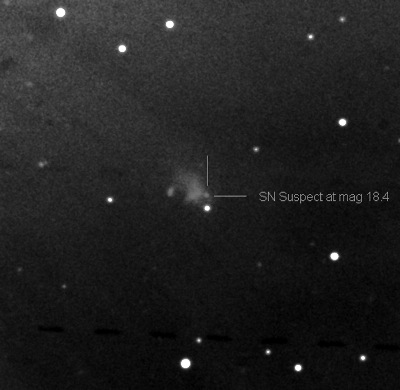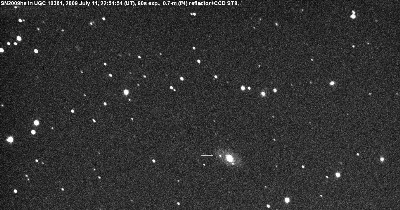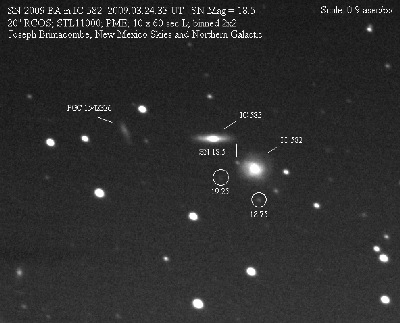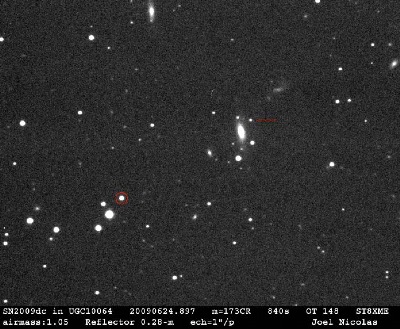
 |
 |
 |
 |
 |
 |
 |
 |
 |
As part of the Puckett Supernova Search Teem
here are our Supernova Discoveries
 Caroline's 1st supernova discovery
Caroline's 1st supernova discovery
SN2008ha
Electronic Telegram No. 1576
Central Bureau for Astronomical Telegrams
INTERNATIONAL ASTRONOMICAL UNION
M.S. 18, Smithsonian Astrophysical Observatory, Cambridge, MA 02138,
SUPERNOVA 2008ha IN UGC 12682
R. J. Foley, Harvard-Smithsonian Center for Astrophysics (CfA),
on behalf of the CfA Supernova Group, reports that a spectrum (range 350-
740 nm) of 2008ha (cf. CBET 1567), obtained on Nov. 18.18 UT by N.
Wright with
the F.L. Whipple Observatory 1.5-m telescope (+ FAST), shows it to be a
type-Ia
supernova, similar to the peculiar supernova 2002cx (see Jha et al.
2006, A.J. 132, 189, for a review of this class of objects). The
spectrum is
similar to SN 2002cx (Li et al. 2003, PASP 115, 453) at 10 days past
maximum
light -- but with a velocity about 3000 km/s lower. Puckett et al.
reported
that 2008ha brightened between Nov. 7 and 9 by 0.6 mag (CBET 1567),
requiring
that the phase of the supernova at the time of this spectrum to be <
9 days
after maximum brightness. If the unfiltered light curve is similar to
that of
the R-band light curve of SN 2002cx, the spectrum of 2008ha should be
<17
days past maximum in the B band, consistent with the phase estimate.
>From
the minimum of the weak absorption line corresponding to Fe II
455.5-nm, a
velocity of -3000 km/s is measured, significantly lower than that of
SNe2002cx
and 2005hk (approximately -5000 km/s and constant for <60 days;
Phillips et
al. 2007, PASP, 119, 360). The spectrum does not have a red continuum,
and there
is no strong Na D absorption in the spectrum, indicating that 2008ha is
not
heavily reddened. Assuming (a) a distance modulus of 31.2 +/- 0.5 mag
--
derived from a redshift of 1393 km/s from Yu et al. (1993, Ap.J. Suppl.
88,
383), and allowing for several flow models; (b) small Milky Way and
host-galaxy
extinction; and (c) that the unfiltered magnitudes reported on CBET
1567
approximate those of the R band, SN 2008ha had an absolute red
magnitude of M_R
= -13 +/- 1 at peak. SNe 2002cx and 2005hk had M_R = -17.6 and -18.3
mag,
respectively. Considering the extremely low absolute magnitude and low
ejecta
velocity, which imply a very low total energy release, Foley et al.
wonder if
2008ha is a true supernova that destroyed the progenitor star; if it
is, then 2008ha is possibly the least luminous supernova ever observed.
NOTE: These 'Central Bureau Electronic Telegrams' are sometimes
superseded by text appearing later in the printed IAU Circulars.
Copyright 2008 CBAT
2008 November 20 (CBET 1576)
Daniel W. E. Green
 Caroline's 2nd supernova discovery
Caroline's 2nd supernova discovery
SN2009he
Electronic Telegram No.1868
Central Bureau for
Astronomical Telegrams
INTERNATIONAL ASTRONOMICAL UNION
Smithsonian Astrophysical Observatory, Cambridge, MA 02138,
SUPERNOVA 2009he IN UGC 10361 T. Puckett, Ellijay, GA, U.S.A.;
and Caroline Moore, Warwick, NY, U.S.A.,
report the discovery of an apparent supernova (mag 17.5)
on unfiltered CCD images (limiting mag 18.9) taken with
a 0.50-m reflector at Ellijay on July 3.16 UT in the course
of the Puckett Observatory Supernova Search. The new object,
which was confirmed at mag 17.5 on images (limiting mag 19.5)
taken by T. Orff on July 4.17 with a 0.60-m reflector at Ellijay,
is located at R.A. = 16h22m12s.33, Decl. = +57o16'22".5
(equinox 2000.0), which is 21".8 east and 6".9 north of the
center of UGC 10361. Nothing is visible at this position on
images taken by Puckett on June 22 (limiting mag 19.4).
NOTE: These 'Central Bureau Electronic Telegrams' are sometimes
superseded by text appearing later in theprinted IAU Circulars.
Copyright 2009 CBAT
2009 July 4(CBET 1868)
Daniel W. E. Green
 Bob's 1st supernova discovery
Bob's 1st supernova discovery
SN2009ba
Electronic Telegram No. 1730Central Bureau for Astronomical
Telegrams INTERNATIONAL ASTRONOMICAL UNION
Astrophysical Observatory Cambridge
MA 02138, U.S.A.
SUPERNOVA 2009ba IN IC 582 T. Puckett
, Ellijay, GA, U.S.A. ;and Robert Moore, Warwick, NY, U.S.A.,
report the discovery of an apparent supernova (mag 18.4)
on unfiltered CCD images (limiting mag 19.7) taken with a 0.35-m reflector at Ellijay on Mar. 21.18 UT in the course of the Puckett Observatory Supernova Search. The new object, which was confirmed at mag 18.3 on images (limiting mag 19.7) taken by T. Orff on Mar. 23.14 with a 0.60-m reflector at Ellijay, is located at R.A. = 9h59m01s.92, Decl. = +17o49m00s.1 (equinox 2000.0), which is 24".1 east and 1".9 south of the center of IC 582. Nothing is visible at this position on images taken by Puckett on Feb. 21 (limiting mag 19.5).
NOTE: These 'Central Bureau Electronic Telegrams' are sometimes
superseded by text appearing later in the printed IAU Circulars.
Copyright 2009 CBAT2009
March 23CBET 1730
)Daniel W. E. Green
 Bob's 2nd supernova discovery
Bob's 2nd supernova discovery
SN2009dc
Electronic Telegram No. 1762Central Bureau for Astronomical Telegrams INTERNATIONAL ASTRONOMICAL UNION
SUPERNOVA 2009dc IN UGC 10064T. Puckett,
Ellijay, GA, U.S.A.; Robert Moore, Warwick, NY, U.S.A.; and J.Newton, Portal, AZ, U.S.A.,report the discovery of an apparent supernova(mag 16.5) on unfiltered CCD images (limiting mag 18.4) taken with a 0.40-mreflector at Portal on Apr. 9.31 UT in the course of the Puckett ObservatorySupernova Search. The new object was confirmed at mag 16.3 on images(limiting mag 18.5) taken by T. Orff on Apr. 10.42 with a 0.40-m reflectorat Portal. SN 2009dc is located at R.A. = 15h51m12s.12, Decl.= +25o42m28s.0 (equinox 2000.0), which is 15".8 west and 20".8 north of the center of UGC 10064. Nothing is visible at this position on images taken by Puckett on Mar. 21 (limiting mag 19.3). NOTE: These 'Central Bureau Electronic Telegrams are sometimessuperseded by text appearing later in the printed IAU Circulars.
Copyright 2009 CBAT2009
April 12(CBET 1762)
Daniel W. E. Green
Page last updated 10-26-09